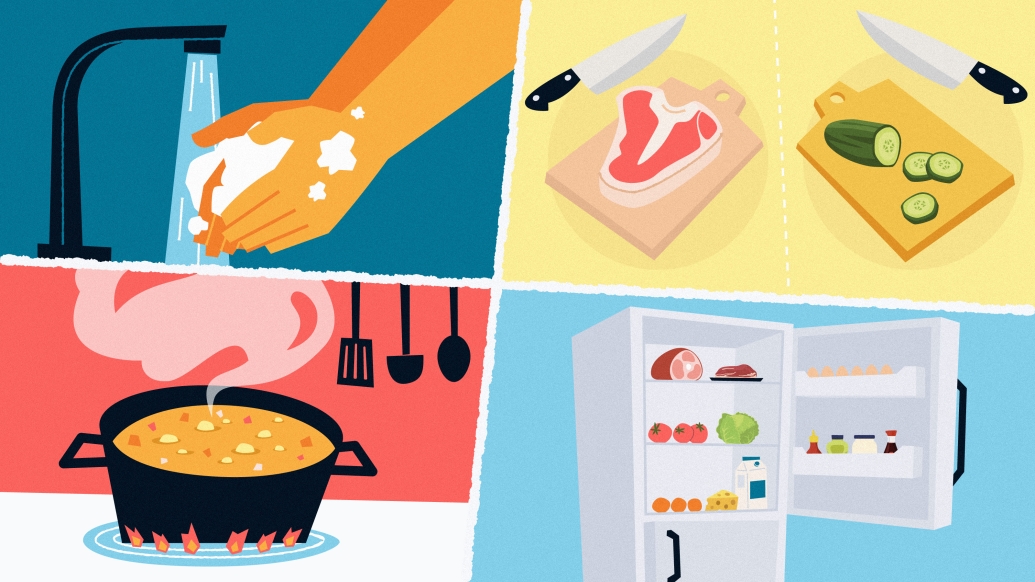About 48 million people fall victim to the unpleasant illness each year. Follow these 6 steps to keep unwanted germs out of your food
1:00 PM
Author |

This story was originally published on May 21, 2018 and was updated on December 17, 2024.
Each year, 1 in 6 Americans get food poisoning.
This figure includes children, generally less than five years old, adults who are above the age of 65, pregnant people, and anyone who may be immunosuppressed.
Typical symptoms include nausea, vomiting, diarrhea and fever, says Alison Tribble, M.D., a pediatric infectious diseases specialist at University of Michigan Health C.S. Mott Children's Hospital.
Foodborne illness from bacteria or viruses can contaminate food items in different ways, including through contaminated water, through raw meat that has not been properly cooked, or due to improper storage of food.
Additionally, more than two-thirds of parents whose children had contracted food poisoning believe they got it from eating at a restaurant, according to a 2018 U-M Health C.S. Mott Children’s Hospital National Poll on Children's Health.
Slightly fewer than one-third of respondents cited spoiled or contaminated food consumed at home as the source.
But the poll also found that most families take precautions: Many respondents said they wash their hands before preparing food (87%), check expiration dates on refrigerated foods (84%) and wash all produce (80%).
Depending on the amount and type of pathogen involved — including E. coli, Salmonella, and norovirus — the arrival time and length of symptoms will vary.
According to Brad Uren, M.D., an emergency medicine physician at U-M Health, foodborne illnesses can be treated at home.
“Try to stay hydrated, and often, the symptoms will self-resolve in just a few hours. However, if those symptoms worsen or if you are at risk due to other medical conditions, you should seek care at an emergency department,” he added.
Fortunately, this pesky illness can often be prevented.
Both Tribble and Uren share simple steps that families can take to reduce the risk before and after a meal.
Tips for preventing food poisoning
1.Keep raw foods cold: Bacteria don't replicate well below 40 degrees Fahrenheit.
Make sure, then, to keep your refrigerator at that temperature to store meat, eggs and produce — and use it to defrost frozen items instead of putting them on the counter to thaw.
"When meat sits out for a long time, bacteria can be replicating, even if the middle is still frozen," Tribble said.
2. Avoid cross-contamination: Use separate cutting boards for meat and vegetables to limit exposure of bacteria to raw produce or other items.
Be sure to clean counters, cutting boards and any related utensils with hot, soapy water before and after prep.
Raw produce also can harbor the bacteria, Tribble says, so rinse all fruits and vegetables before chopping or serving.
3. Cook meat properly: To kill all bacteria, make sure meat is heated to the right internal temperature.
That's 165 degrees Fahrenheit for ground beef, 160 degrees for chicken and 145 degrees for whole cuts of meat such as beef and pork.
“Always use a food thermometer to ensure that you’ve hit a safe temperature before serving,” Uren said.
4. Don't leave leftovers out: Whether it's homecooked food or restaurant takeout, refrigerate the items after they've been exposed to open air for more than two hours, Uren emphasizes.
The reason: Bacteria can grow and multiply in a short amount of time — a particular risk if food is already contaminated from improper cooking or unclean hands.
5. Check for FDA recalls and health code violations: Before going grocery shopping, check which FDA-regulated products have been recalled.
If you choose to dine at a restaurant, consider reviewing their health department inspection records; the reports look for proper temperature storage and overall cleanliness, among other things.
Tribble also advises checking a child's food to ensure items appear well-cooked.
6. Wash your hands: The easiest way to prevent foodborne illness? Basic hygiene.
"Hand-washing is really the most important thing to teach your kids," said Tribble, noting that the process should last at least 20 seconds and involve hand soap.
That's especially key after using the restroom (and before cooking or eating) to keep bacteria and viruses from spreading from hands to food.
Sign up for Health Lab newsletters today. Get medical tips from top experts and learn about new scientific discoveries every week.
Sign up for the ealth Lab Podcast. Add us wherever you listen to your favorite shows.

Explore a variety of health care news & stories by visiting the Health Lab home page for more articles.

Department of Communication at Michigan Medicine

Clinical Associate Professor

Clinical Associate Professor
Want top health & research news weekly? Sign up for Health Lab’s newsletters today!





